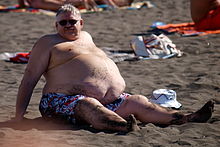I remember returning home from University for Christmas. It was the middle of the day when I saw my mother reaching into a large tin and pulling out some sugary sweets.
“No wonder you´re having trouble losing weight,” I remarked with my typical lack of diplomacy.
“Your metabolism slows down as you age!” she snapped. “You´re just lucky that you have a high metabolism. You wait until you get to my age.”
That was over thirty years ago and now I am approaching my 50th birthday. I have to admit that during the last five years I have noticed that I need to work a bit harder to maintain my shape so I looked into the scientific journals for some clarity on the subject.

Is our declining metabolism due to age or lifestyle?
Here is what the research says…
Adults who don´t do any form of muscle strength training lose between 5-7 pounds of muscle every decade (1). Because muscle is very active tissue, muscle loss results in a lowering of your metabolism. Studies indicate that the average adult experiences anything from a 1- 3 percent reduction in their metabolic rate per decade of their life (2,3) until they reach around the age of 50 (4). From then, your metabolism stays around the same.
The research now clearly shows that the largest proportion of this drop in metabolic rate is NOT due to the natural ageing process (5). It is in fact due to the loss of muscle.
The two major causes of muscle loss are:
1) Dieting
Calorie restrictive diets that don´t supply enough energy to maintain proper body function don´t supply sufficient energy to the muscles to sustain them. As a result, the muscles begin to breakdown. Because muscle is heavier than fat, the dieter is often delighted with the rapid weight loss but unaware that the resultant drop in metabolism will more than likely cause them to put on more weight than ever.
2) The DUIYLI (Don´t Use It You Lose It) Syndrome.
The major problem is that as you age you start doing old. You get fooled into thinking that as you get to a certain age, it is inappropriate to do a lot of activity. For those that think that should consider changing the word “retire” (meaning to slow down) to “re-tire” (which means to put on another set of tires and keep going).
Research also suggests that we are using our muscles even less than 30 years ago with an average 1.5 percent reduction in metabolism per decade measured in 1972 (1) compared with an average 2.6 percent reduction in metabolism per decade measured in 2001 (3) thanks to televisions and computers.
Because most adults do not perform strength training, they need to first replace the muscle they have lost through inactivity. Fortunately, research shows that two 25-minute sessions per week of strength training can increase muscle mass by about 3 pounds over 8 weeks. (6) That alone can increase your resting metabolic rate by 7 percent. (7).
Now if you have let yourself get totally out of shape over the years the good news is that just by following a basic aerobic fitness program, your body will put on muscle and your metabolism will improve.
You can´t change time but you can change your metabolism.
References
1) Evans, W. and Rosenberg, I. (1992) Biomarkers, New York: Simon and Schuster. Forbes, G. B. (1976). “The adult decline in lean body mass,” Human Biology, 48: 161-73
2) Keys, A., Taylor, H.L. & Grande, F. 1973. Basal metabolism and age of adult man. Metab. 22: 579-587
3) Roberts, S. & Dallal, D.E. 2001. Energy requirements and ageing. Energy working paper No. 8R prepared for the joint FAO/WHO/UNU Expert Consultation on Energy in Human Nutrition, 2001.
4) Poehlman, E.T. 1992. Energy expenditure and requirements in ageing humans. J. Nutr. 122: 2057-2065
5) Piers, L.S., Soares, M.J., McCormack, L.M. & O´Dea, K. 1998. Is there evidence for an age-related reduction in metabolic rate? J. Appl. Physiol., 85: 2196-2204.
6) Westcott, W. and Guy, J. (1996). A physical evolution. Sedentary adults see marked improvements in as little as two days a week. IDEA Today, 14 (9): 58-65.
7) Campbell, W., Crim, M., Young, V. and Evans, W. (1994). Increased energy requirements and changes in body composition with resistance training in older adults. American Journal of Clinical Nutrition, 60: 167-175.
